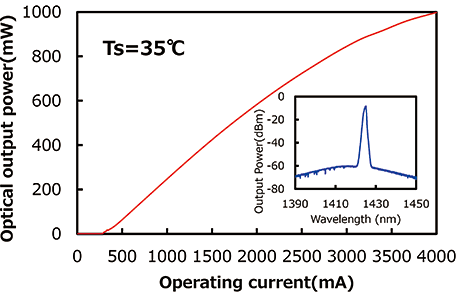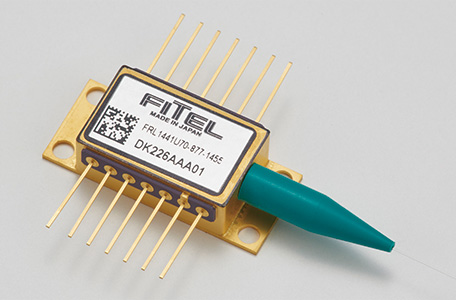Expanded bandwidth of FRL1441U Series – pump lasers for high output, low power consumption Raman amplifiers – for U-band application
- Also succeeded in further increasing output power of the entire Series by optimizing laser chip design -
- Expansion of bandwidth of FRL1441U Series – pump lasers for high output, low power consumption Raman amplifiers – enabled U-band application, contributing to expanding transmission wavelength range
- Mass production of pump lasers for all S-, C-, L- and U-bands will start from this April
- The pump laser for the C-band achieved fiber output of 1W at 35℃, contributing to achieving lower power consumption as a result of reducing reactive power
Furukawa Electric Co., Ltd. (Head Office: 2-6-4 Otemachi, Chiyoda-ku, Tokyo; President: Hideya Moridaira) expanded the lineup of FRL144U Series, pump lasers for high output, low power consumption Raman amplifiers, to include newly developed pump laser for the U-band by expanding bandwidth from existing S-, C-, and L-bands, and will start mass production from April of this year. Furthermore, we optimized the design of laser chips mounted on existing FRL1441U Series, achieved fiber output of 1W at 35℃ in C-band, and developed pump lasers which allow for further lowering power consumption by reducing reactive power.
Background
While communication traffic volume at data centers or elsewhere has been increasing on the background of the popularization of cloud service and the emergence of generative AI, along with increasing data transmission speed, the transmission distance decreases due to degradation of the OSNR (note 1) on the signal receiving side. In particular, when existing communication systems are used at faster transmission speeds, the role of the Raman amplifier, which can amplify optical output power without attenuation of the signal light quality, will become more important. Also, because the bandwidth of the signal expands as a result of high-speed transmission, it is necessary to extend the bandwidth in order to enable high volume transmission. Thus, Raman amplifiers need to have high flexibility to amplify the light source at a discretionary range based on the selection of the pump laser wavelength. On the other hand, with the expansion into the U-band, the number of pump lasers used increases, so it is even more important for them to have high output power and low power consumption. In October 2022, Furukawa Electric achieved 800mW output in the C-band, and also expanded the lineup to include a 700mW pump laser for the S-band and low power consumption 500mW pump laser for the L-band. Product sample shipments of these pump lasers began in April 2023. With the FRL1441U Series, we have reduced the power consumption of the pump lasers used for existing Raman amplifiers in the S-, C-, and L-bands by 37% and made it possible to reduce the space used by using only 1 pump laser instead of the previous 2 unit through the development of the dual port pump laser.
Details
This time, to support further expansion of bandwidth, based on the specification for the L-band, specifically 500mW output and maximum power consumption of 10W, we added a pump laser for Raman amplifiers for the U-band (wavelength range: 1520-1545nm), where achieving a higher output power was challenging, to the lineup of FRL1441U Series. Product sample shipment starts from January of this year, and mass production is scheduled to begin in April (See Table below).
Furthermore, while fiber output from the existing product for C-band is 800mW when the driving current is 4A at 35℃, this product achieved 1W as a result of optimizing the laser chip design (Fig. 1). Similarly to the existing products, this product was developed in the 14-pin butterfly package (Fig. 2), thereby reducing reactive power and contributing to further lowering power consumption. In order to offer more technical advantages to FRL1441U Series, we reduced electrical resistance of laser chip by more than 10% by optimizing the design of the chip, and developed the laser chip which enables high output power with low power consumption. On this background, it uses our optical semiconductor processing technology using InP (note 2) semiconductor materials developed over more than 25 years and high accuracy fiber coupling technology, as well as the application of our unique low loss, high efficiency semiconductor laser chip structure. It also takes advantage of the optimized design of our patented high efficiency semiconductor laser chip structure.
An oral presentation of this product will be made at Photonics West 2024 to be held in San Francisco, USA, in January of this year (on Jan. 29, 2024).
The current development was conducted and achieved as part of the National Institute of Information and Communications Technology (NICT) commissioned research “Beyond 5G – Development of extended range optical node technology for realizing ultra-high speed, large volume networks” (Key Issue JPJ012368C04501).
Going forward, we will continue to develop high output, low power consumption laser chip technology and contribute to accelerated reductions in module power consumption and the establishment of environmentally-friendly networks.
| Model | FRL1441U Series | |||
|---|---|---|---|---|
| Bandwidth | S-band | L-band | U-band | |
| Optical output power (mW) | 700 | 600 | 500 | |
| Power consumption (W) | Max. 14 | Max. 10 | Max. 10 | |
| Operating conditions | Ts=35℃, Tc=70℃(EOL) | |||
(note 1)OSNR (Optical Signal to Noise Ratio): Parameter that indicates the signal-to-noise ratio
(note 2)InP (Indium Phosphide): A III-V compound semiconductor that is used for the manufacture of laser diode chips and high speed transistors
Related News Release
Furukawa Electric Group’s efforts towards the SDGs
Based on the “Sustainable Development Goals (SDGs)” adopted by the United Nations, Furukawa Electric Group has formulated the “Furukawa Electric Group Vision 2030” which sets the year 2030 as its target and is advancing efforts with the aim to “Build a sustainable world and make people’s life safe, peaceful and rewarding, Furukawa Electric Group will create solutions for the new generation of global infrastructure combining information, energy and mobility.” Toward the achievement of our Vision 2030, we will take open, agile, and innovative approaches to promote ESG management that aims to increase corporate value over the medium to long term and will contribute to the achievement of the SDGs.









 Share
Share Tweet
Tweet Share
Share